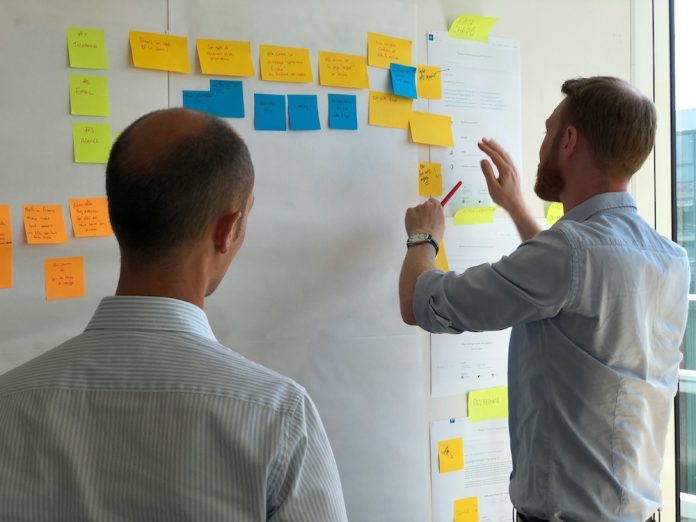
A great leadership development program goes beyond delivering content and creates an experience that supports learning, engagement, and real-world application. At the end of the day, your participants are your customers, and their learning experiences should reflect that. When participants feel comfortable, energized, and connected to the material, they are far more likely to walk away with insights that stick.
10 Essential Factors
A participant-centric approach considers how leaders progress through the program, interact with content, and experience the learning environment. Here are 10 essential factors to ensure your leadership development program is set up for success.
-
Set a consistent daily rhythm.
Humans thrive on routine. Maintaining a consistent schedule, especially for key moments such as lunch and breaks, helps participants stay engaged and manage their energy levels. When break times shift unpredictably, participants become distracted, wondering when they’ll have time to recharge.
Pro tip: Make sure meal options accommodate dietary restrictions and preferences so no one has to scramble for food. Consider providing healthy snacks in the afternoon to combat the midafternoon sleepiness many people experience.
-
Cap in-person programs at three days to support work-life balance.
Time away from work for learning is an investment. A three-day program allows for Monday and Friday travel, minimizing disruptions to participants’ workweek while still providing an immersive learning experience. Extending beyond three days often leads to declines in focus and attendance.
Pro tip: Want deeper engagement? Supplement in-person sessions with pre-work, virtual discussions, or follow-up coaching rather than extending the in-person commitment.
-
Build in time for reflection and processing.
Cramming content into back-to-back sessions doesn’t support learning—it overwhelms participants. There’s a saying in sales: “An overwhelmed buyer buys nothing.” The same applies to learners. Leaders need dedicated time to reflect, connect concepts to their own experiences, and determine how they’ll apply new ideas in their roles. Yet, these are often the activities that get shortchanged in an agenda, even though they’re the most valuable for learning. Protect this time at all costs.
Pro tip: Ways to integrate reflection:
- Structured journaling or self-reflection prompts
- Small group discussion and synthesis activities
- Simple, quiet thinking time before moving to the next concept
-
Offer content in multiple formats.
Not everyone learns the same way. Some participants prefer visual content, others absorb information best by listening, and many learn most effectively through hands-on experience.
Pro tip: To make content accessible to all learners, include:
- Infographics and slides for visual learners
- Storytelling and discussions for auditory learners
- Hands-on simulations and activities for kinesthetic learners
- Digital follow-up resources for ongoing reference
-
Choose a room that supports learning.
The learning environment plays a crucial role in engagement. A cramped, dark, or windowless room can drain energy, while a well-lit and well-organized space enhances focus and interaction.
Pro tip: Key factors to consider:
- Natural light (if possible) to keep participants alert
- Flexible seating arrangements that encourage discussion and movement
- Clear sightlines to speakers, screens, and materials
- Good acoustics or access to microphones so everyone can hear clearly
-
Prioritize smooth logistics.
Even small logistical hiccups can become major distractions. Confusing instructions, missing materials, or inaccessible food can pull participants’ focus away from the learning experience.
Pro tip: To avoid disruptions:
- Send clear pre-program communications about location, schedule, and materials.
- Test AV and tech setups in advance and ensure an AV team is readily available.
- Make sure meals and breaks are easy to access and close to the learning space.
-
Use real-world scenarios to enhance learning.
Adults learn best when they see how concepts apply to their own challenges. Case studies, role plays, and decision-making exercises based on real-world leadership situations help participants practice what they’re learning in a risk-free setting.
Pro tip: Make it relevant by:
- Using industry-specific examples whenever possible
- Encouraging participants to apply concepts to their own leadership challenges
- Incorporating simulations that mirror real decision-making scenarios
-
Foster connection and peer learning.
Leadership programs shouldn’t just be about learning from the facilitator. They should encourage peer learning. Participants bring valuable experience to the table, and when they engage with each other, the learning deepens.
Pro tip: Ways to encourage connection:
- Include small-group discussions or breakout activities focused on real work challenges.
- Provide structured networking opportunities.
- Incorporate peer coaching and feedback exercises.
-
Offer flexibility for different learning preferences.
Some leaders love participating in discussions, while others prefer to process information quietly before speaking. A participant-centric approach accommodates different engagement styles without forcing interaction in ways that feel uncomfortable.
Pro tip: To make the program inclusive for all:
- Provide think time before group discussions.
- Use anonymous response tools for introverts to contribute.
- Balance individual, small-group, and large-group activities.
-
Provide clear takeaways and next steps.
The best leadership development programs don’t end when participants leave the room. To drive real behavior change, leaders need clear next steps for applying what they’ve learned.
Pro tip: Ways to support ongoing application:
- Provide action planning templates at the end of the program with suggested manager checkpoints.
- Schedule follow-up coaching or check-ins.
- Share digital resources or readings for continued learning.
Inspired to Apply Insights
The best leadership development program isn’t defined by what you teach alone, but by the environment you create to make learning stick. By prioritizing a participant-centric approach, you ensure leaders walk away not just inspired but equipped to apply their insights in the real world. Thoughtful program design that considers structure, engagement, and real-world relevance transforms leadership training from an event into an experience that fuels long-term growth.
When participants feel valued, supported, and connected to the material, they don’t just learn; they lead.

